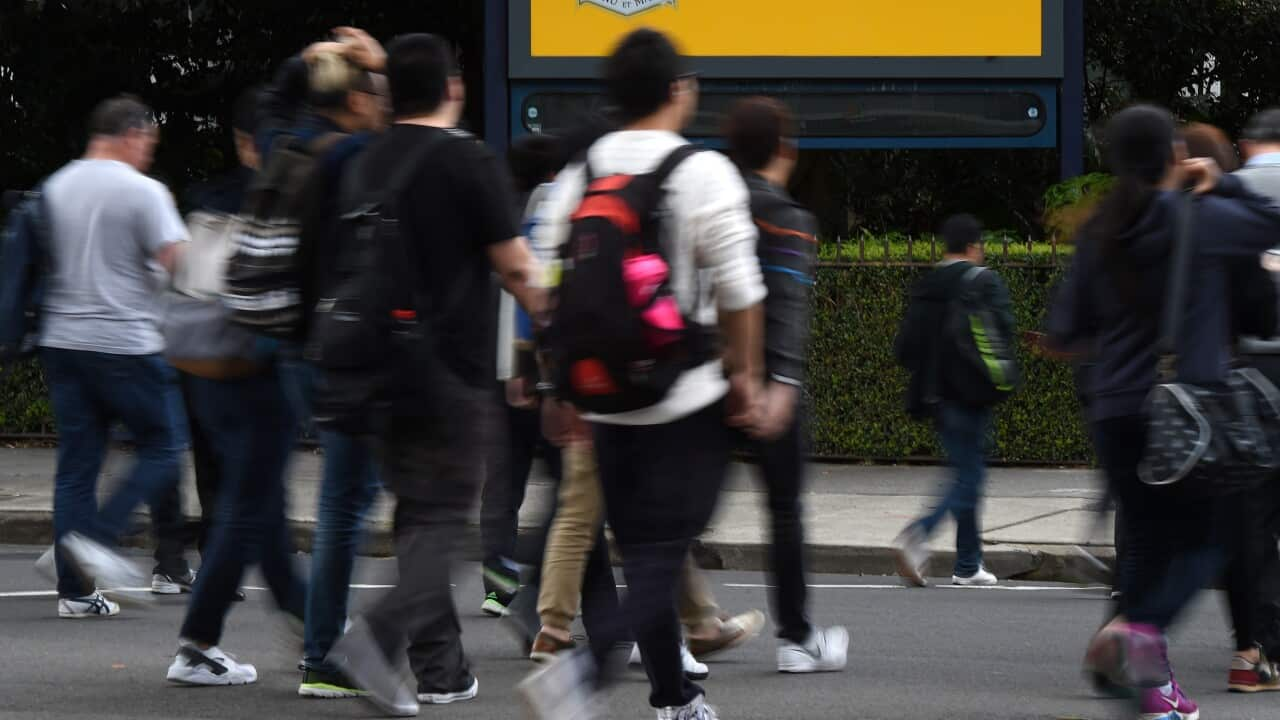Key Points
- From 1 June this year, the indexation rate applied to HELP-HECS loans rose to 3.9 per cent.
- While experts say this won't have short-term consequences, students are worried about accruing debt.
Oscar Chaffey is a full-time medical student in Sydney with a HECS-HELP debt of almost $50,000 - and it’s only growing.
Their studies started in 2018 with a bachelor of science, majoring in anatomy. Last year, they started a four-year, postgraduate degree in medicine.
Oscar’s student debt currently sits at just over $47,000, which equates to about $5,000 per semester they’ve been at university.
“I think it’s almost a truism that I’m worried about a debt of almost $50,000 that will only grow by tens of thousands of dollars before I have any means with which to pay it back,” they told SBS News.
Tens of billions in outstanding debt
Oscar is among almost three million Australians who are facing a payment increase on their outstanding loans.
From 1 June this year, the indexation rate applied to study and training loans such as HECS-HELP rose to 3.9 per cent - up from 0.6 per cent in 2021 and the highest in 10 years.
“I have two more years of studies, by which time I expect it [my debt] to inflate to well over $70,000, both due to indexation and the $10,000 - $11,000 per year student contribution to medical degrees,” Oscar said.
Prior to the COVID-19 pandemic - between 2018 and 2020 - the indexation rate hovered around two per cent.
How much student debt is owed?
According to Australian Tax Office (ATO) data, there were 2.9 million people with outstanding HECS-HELP debt in 2020-21, totalling more than $68.7 billion.
The average amount of outstanding debt per person was $23,685 - up from $23,280 the previous year.
This means the higher rate would raise the average person’s amount of debt by about $923. For Oscar, it means over $1,350. Previously, their indexations have been between $75 to $200.
“$1,350 is not an abstract amount of money for me or indeed for most students,” they said.
“It’s depressing that in Australia, a country where education was once seen as a public good, young people are now expected to place themselves into this much debt in order to get educated.”
'Balloon of student debt'
National Union of Students president Georgie Beatty said students were struggling with what is becoming a “massive financial burden” as they also faced cost of living pressures.
“This loan is becoming just another barrier in an already inaccessible tertiary education system,” she told SBS News.
Ms Beatty, who is an arts student herself, said students are “racking up debt that’s going to delay them from starting a family, from buying a house and keeping them in poverty longer”.
“They’re just trying to survive and get through. And meanwhile, they have this balloon of student debt hanging over their heads,” she said.
As a full-time student expected to dedicate 40 hours a week to their studies, Oscar says they’re locked out of being able to afford voluntary contributions to their debt, or being able to earn enough to offset it.
On top of this, they’re feeling the burden of the Sydney rental market.
“It’s a hard time on university students, and I am far from the most vulnerable or necessarily sympathetic example,” they said.
“The financial stress of this kind of debt forecloses tertiary education for many people entirely, especially in an environment where cost of living is increasingly out of sight.”
HECS-HELP is an interest-free loan scheme, but is indexed to inflation.
The ATO says indexation maintains the real value of the loan by adjusting it in line with changes in the cost of living, as measured by the consumer price index (CPI), which is the commonly used indicator of inflation.
What do those behind HECS say?
Emeritus Professor Bruce Chapman, from the Australian National University (ANU), was one of the architects of the HECS system.
He said the scheme - designed to help students to attend university without paying upfront fees - means the government pays a university for a place, which the student later repays, depending on their income.
“In a world with some inflation, if there’s no indexation going on, in real terms, the government would be getting back less than it paid,” he told SBS News.
“So an indexation is a way of adjusting the stock of the debt to take into account the time involved in the repayment, so that the government doesn’t subsidise too heavily.
“It’s kind of like an interest rate, but it’s still a subsidised interest rate.”
Professor Chapman said the indexation rise is “not a surprise” because “we’ve always had an adjustment for price inflation”.
“In terms of HECS-HELP, it really is not very important in my view, because it’s still adjusting the debt just for the actual, true value of that debt. So if it was really huge, say 30 per cent, you'd start to see that maybe that will have effects on behaviour - but only so long as wages aren't keeping up with prices.”
Currently, inflation is sitting at 5.1 per cent, the highest level in 20 years, with the rate . Wage growth in Australia is sitting at 2.4 per cent.
Professor Chapman said the adjustment to HECS-HELP debt is “not very big” and will have no consequences until a person reaches the end of their repayments.
“If the total stock of the debt is adjusted upwards by a nominal amount of 4 per cent, that has no consequence for you in the short run,” he said.
“What it does is that it adds to the nominal stock of debt that you have, which will then make the repayment of HECS slightly longer than before.”
He predicts the increased rate will have no “behavioural” effects, such as changing the way people choose to enter the labour market.
But Ms Beatty argued that for some, it can not be understated.
“I mean, as someone who works very low, minimum wage jobs … that’s a lot of money,” she said.
She said the rising cost of some degrees, under a policy of the former Coalition government, was also compounding the issue.
In 2020, the then government passed its funding policy to deliver more “job ready graduates” by encouraging students to consider studying in high-priority sectors.
Under the changes, fees for courses that led to jobs in sectors such as health and teaching were cut, while the cost of already-popular degrees, such as arts and law, increased.
The student contribution for law and commerce increased by 28 per cent, and by 113 per cent for humanities. Fee contributions were grandfathered to apply to students from 2021.
Ngaire Bogemann is studying a bachelor of arts in Melbourne, and was part of the first cohort of students affected by the policy changes.
“My situation is quite unique because I major in both politics and international studies and French, which puts me in a very weird position where half of my degree has gone up in price, and the other half of my degree has gone down in price,” she told SBS News.
She said she pays about $450 for a French subject, and just under $2,000 for politics subjects, which can impact the overall cost of a semester.

Ngaire Bogemann is an arts student in Melbourne who was impacted by the former Coalition government's Jobs Ready Graduate Program. Source: Supplied
“For me, knowing that I have so much debt accruing, aspiring to own a home or buy a car or do any of those big adult things, it seems really unreachable,” she said.
“And I feel a lot of pressure now to go into a job where I can start paying off my HECS debt and get it done quicker.”
She said having “another layer” added to cost of living pressures “makes me feel a lot of dread”.
A spokesperson for the Department of Education said a review into the Jobs Ready Graduate Package will start in the second half of this year, in line with the timeline set by the previous government.
Ms Beatty welcomed a review of the package, and said a change would be “life-changing for so many students”.
What should I do if I’m struggling?
HECS-HELP assists people to repay student contributions once their earnings reach a certain level.
Under the 2022-23 thresholds, graduates must start to repay their HELP loans when they earn above $48,361 at a rate of 1 per cent. Higher salaries attract higher repayments, with those earning between $62,739 – $66,502 paying 3 per cent, and those earning $88,997 – $94,336 paying 6 per cent. This rises to 10 per cent for those earning above $141,848.
The department spokesperson said HELP payments are a set percentage of your income so they don’t go up unless your salary does. They said those who are experiencing hardship should contact the ATO to discuss their options.













